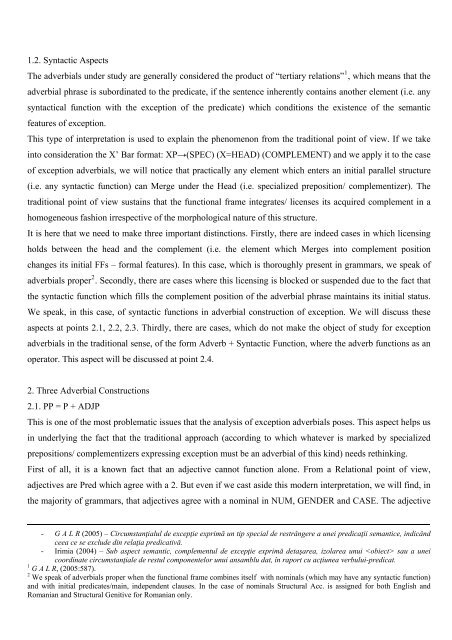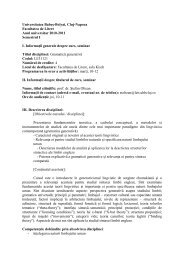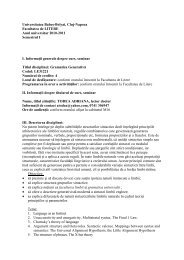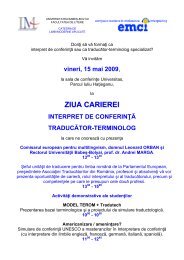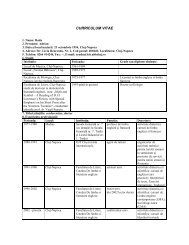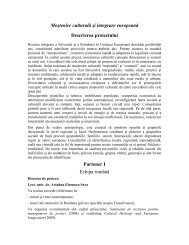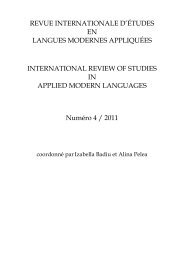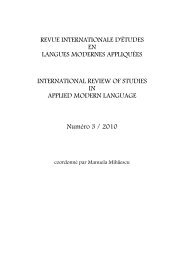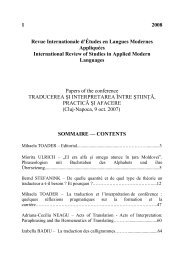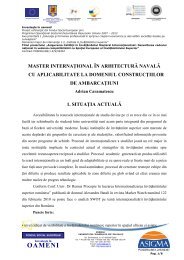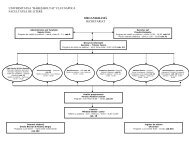Dimensiuni ale limbajului n context carceral
Dimensiuni ale limbajului n context carceral
Dimensiuni ale limbajului n context carceral
Create successful ePaper yourself
Turn your PDF publications into a flip-book with our unique Google optimized e-Paper software.
1.2. Syntactic Aspects<br />
The adverbials under study are generally considered the product of “tertiary relations” 1 , which means that the<br />
adverbial phrase is subordinated to the predicate, if the sentence inherently contains another element (i.e. any<br />
syntactical function with the exception of the predicate) which conditions the existence of the semantic<br />
features of exception.<br />
This type of interpretation is used to explain the phenomenon from the traditional point of view. If we take<br />
into consideration the X’ Bar format: XP→(SPEC) (X=HEAD) (COMPLEMENT) and we apply it to the case<br />
of exception adverbials, we will notice that practically any element which enters an initial parallel structure<br />
(i.e. any syntactic function) can Merge under the Head (i.e. specialized preposition/ complementizer). The<br />
traditional point of view sustains that the functional frame integrates/ licenses its acquired complement in a<br />
homogeneous fashion irrespective of the morphological nature of this structure.<br />
It is here that we need to make three important distinctions. Firstly, there are indeed cases in which licensing<br />
holds between the head and the complement (i.e. the element which Merges into complement position<br />
changes its initial FFs – formal features). In this case, which is thoroughly present in grammars, we speak of<br />
adverbials proper 2 . Secondly, there are cases where this licensing is blocked or suspended due to the fact that<br />
the syntactic function which fills the complement position of the adverbial phrase maintains its initial status.<br />
We speak, in this case, of syntactic functions in adverbial construction of exception. We will discuss these<br />
aspects at points 2.1, 2.2, 2.3. Thirdly, there are cases, which do not make the object of study for exception<br />
adverbials in the traditional sense, of the form Adverb + Syntactic Function, where the adverb functions as an<br />
operator. This aspect will be discussed at point 2.4.<br />
2. Three Adverbial Constructions<br />
2.1. PP = P + ADJP<br />
This is one of the most problematic issues that the analysis of exception adverbials poses. This aspect helps us<br />
in underlying the fact that the traditional approach (according to which whatever is marked by specialized<br />
prepositions/ complementizers expressing exception must be an adverbial of this kind) needs rethinking.<br />
First of all, it is a known fact that an adjective cannot function alone. From a Relational point of view,<br />
adjectives are Pred which agree with a 2. But even if we cast aside this modern interpretation, we will find, in<br />
the majority of grammars, that adjectives agree with a nominal in NUM, GENDER and CASE. The adjective<br />
- G A L R (2005) – Circumstanţialul de excepţie exprimă un tip special de restrângere a unei predicaţii semantice, indicând<br />
ceea ce se exclude din relaţia predicativă.<br />
- Irimia (2004) – Sub aspect semantic, complementul de excepţie exprimă detaşarea, izolarea unui sau a unei<br />
coordinate circumstanţi<strong>ale</strong> de restul componentelor unui ansamblu dat, în raport cu acţiunea verbului-predicat.<br />
1 G A L R, (2005:587).<br />
2 We speak of adverbials proper when the functional frame combines itself with nominals (which may have any syntactic function)<br />
and with initial predicates/main, independent clauses. In the case of nominals Structural Acc. is assigned for both English and<br />
Romanian and Structural Genitive for Romanian only.


